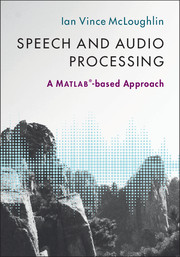Refine search
Actions for selected content:
3326 results in Artificial Intelligence and Natural Language Processing
6 - Speech communications
-
- Book:
- Speech and Audio Processing
- Published online:
- 05 June 2016
- Print publication:
- 21 July 2016, pp 140-194
-
- Chapter
- Export citation
8 - Big data
-
- Book:
- Speech and Audio Processing
- Published online:
- 05 June 2016
- Print publication:
- 21 July 2016, pp 223-266
-
- Chapter
- Export citation
3 - The human voice
-
- Book:
- Speech and Audio Processing
- Published online:
- 05 June 2016
- Print publication:
- 21 July 2016, pp 54-84
-
- Chapter
- Export citation
1 - Introduction
-
- Book:
- Speech and Audio Processing
- Published online:
- 05 June 2016
- Print publication:
- 21 July 2016, pp 1-8
-
- Chapter
- Export citation
References
-
- Book:
- Speech and Audio Processing
- Published online:
- 05 June 2016
- Print publication:
- 21 July 2016, pp 370-378
-
- Chapter
- Export citation
11 - Conclusion
-
- Book:
- Speech and Audio Processing
- Published online:
- 05 June 2016
- Print publication:
- 21 July 2016, pp 366-369
-
- Chapter
- Export citation
5 - Psychoacoustics
-
- Book:
- Speech and Audio Processing
- Published online:
- 05 June 2016
- Print publication:
- 21 July 2016, pp 109-139
-
- Chapter
- Export citation
Improving mention detection for Basque based on a deep error analysis
-
- Journal:
- Natural Language Engineering / Volume 23 / Issue 3 / May 2017
- Published online by Cambridge University Press:
- 12 July 2016, pp. 351-384
-
- Article
- Export citation
A transformation-driven approach for recognizing textual entailment†
-
- Journal:
- Natural Language Engineering / Volume 23 / Issue 4 / July 2017
- Published online by Cambridge University Press:
- 16 June 2016, pp. 507-534
-
- Article
-
- You have access
- HTML
- Export citation
Building and using multimodal comparable corpora for machine translation†
-
- Journal:
- Natural Language Engineering / Volume 22 / Issue 4 / July 2016
- Published online by Cambridge University Press:
- 15 June 2016, pp. 603-625
-
- Article
- Export citation
NLE volume 22 issue 4 Cover and Front matter
-
- Journal:
- Natural Language Engineering / Volume 22 / Issue 4 / July 2016
- Published online by Cambridge University Press:
- 15 June 2016, pp. f1-f2
-
- Article
-
- You have access
- Export citation
Preface
-
- Journal:
- Natural Language Engineering / Volume 22 / Issue 4 / July 2016
- Published online by Cambridge University Press:
- 15 June 2016, pp. 497-500
-
- Article
-
- You have access
- HTML
- Export citation
End-to-end statistical machine translation with zero or small parallel texts†
-
- Journal:
- Natural Language Engineering / Volume 22 / Issue 4 / July 2016
- Published online by Cambridge University Press:
- 15 June 2016, pp. 517-548
-
- Article
- Export citation
Building a multi-domain comparable corpus using a learning to rank method†
-
- Journal:
- Natural Language Engineering / Volume 22 / Issue 4 / July 2016
- Published online by Cambridge University Press:
- 15 June 2016, pp. 627-653
-
- Article
- Export citation
Recent advances in machine translation using comparable corpora
-
- Journal:
- Natural Language Engineering / Volume 22 / Issue 4 / July 2016
- Published online by Cambridge University Press:
- 15 June 2016, pp. 501-516
-
- Article
-
- You have access
- HTML
- Export citation
Extracting parallel phrases from comparable data for machine translation†
-
- Journal:
- Natural Language Engineering / Volume 22 / Issue 4 / July 2016
- Published online by Cambridge University Press:
- 15 June 2016, pp. 549-573
-
- Article
- Export citation
Exploiting unbalanced specialized comparable corpora for bilingual lexicon extraction†
-
- Journal:
- Natural Language Engineering / Volume 22 / Issue 4 / July 2016
- Published online by Cambridge University Press:
- 15 June 2016, pp. 575-601
-
- Article
- Export citation
NLE volume 22 issue 4 Cover and Back matter
-
- Journal:
- Natural Language Engineering / Volume 22 / Issue 4 / July 2016
- Published online by Cambridge University Press:
- 15 June 2016, pp. b1-b4
-
- Article
-
- You have access
- Export citation

Speech and Audio Processing
- A MATLAB®-based Approach
-
- Published online:
- 05 June 2016
- Print publication:
- 21 July 2016
NERA 2.0: Improving coverage and performance of rule-based named entity recognition for Arabic*
-
- Journal:
- Natural Language Engineering / Volume 23 / Issue 3 / May 2017
- Published online by Cambridge University Press:
- 06 May 2016, pp. 441-472
-
- Article
- Export citation
